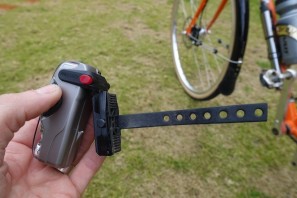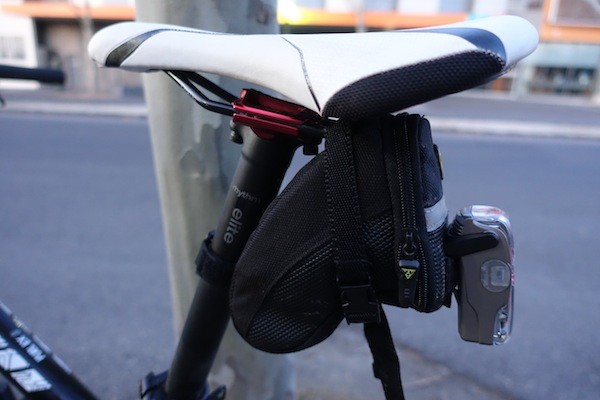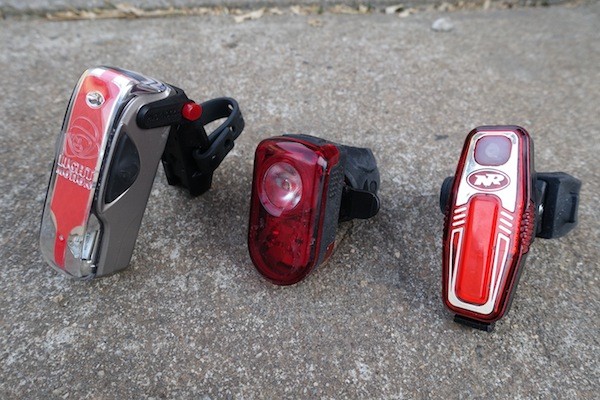As modern LED and battery technology continues to raise the performance bar, the new wave of high-powered bicycle lights currently hitting the market are without doubt the most powerful and efficient we have ever seen. Remember the days of sealed-lead acid batteries and halogen globes? We do too, though thankfully those days are long gone! But as compact and as eyeball-tearingly powerful as some front lights have gotten (how’s that 6000-Lumen Halo light from TrailLED?!), sometimes it’s easy to forget that rear lights are also improving too.
For road and urban riders, having a highly visible rear light is arguably more important than having a stoopid-powerful front light, mostly because you don’t have eyes in the back of your head. And quite frankly, we need to give drivers as much help as they can possibly get when it comes to noticing us on the road.
The Vis 180 tail light from Californian company Light & Motion is a great example of how modern lighting technology is making us more visible, and (hopefully) safer. 70 Lumens of LED-driven power, a claimed 6-hour run time, and a compact alloy body make the Vis 180 one of the big boys in the lighting game. Does it live up to the price-tag? Read on for the full review!
The original Vis 180 was first introduced in early 2011. It entered the scene as the first rechargeable tail light on the market, setting the bar for everyone else. Nowadays, I wouldn’t even consider buying a new rear light that isn’t USB rechargeable. Since that first model, the Vis 180 has received a number of updates that have seen increases in both LED power and battery efficiency. As with all Light & Motion lights, the Vis 180 is 100% designed, engineered, tested and assembled in their Monterey factory, with up to 80% of the end product utilising materials sourced within the US. When we last checked out the Vis 180, it was still 35 lumens which seemed quit powerful at the time. Now, it’s been ratcheted up to double the output with a full 70 lumens!
“Refined rear lighting ideal for cyclists whose protective visibility is paramount. The Vis 180 was engineered to redefine bicycle tail-lighting by providing a distinct 180 degree spectrum of light. Powerful red LEDs coincide with hi-intensity amber side lighting giving commuters peace of mind to focus on the road ahead. Simple and secure seat-post mounting allow tool-free removal and installation between various bicycles. Micro-USB charging gives users a straightforward solution to charge almost anywhere. The Vis 180 sets itself apart as the premier tail-light cyclists can rely on.” – Light & Motion
The Light & Motion Vis 180 Light features:
- Power: 70 Lumens
- Dual LED array for 180-degree visibility
- Durable Alloy body
- Tilt-adjustable mount w/rubber mounting strap
- USB Rechargeable Lithium Ion Battery
- Separate battery charge and status indicator
- Settings: High Pulse, Low Pulse, Solid & Paceline
- Run Time: 6 hours (High), 12 hours (Low)
- Certified to the FL-1 Standard
- 2-Year Warranty
- Claimed weight: 102 grams
- MSRP: $100 USD / $150 AUD
Measuring 8cm in length and 3cm in width, the Vis 180 is one of the larger rear lights I’ve used. The light body is constructed with an alloy casing, which gives it added strength and durability over an all-plastic light. It does mean that the Vis 180 is relatively chunky though, coming in at a confirmed weight of 108 grams. Along with the light body’s dimensions, the Vis 180 certainly has ‘presence’ when mounted to your bike. The Vis 180 uses a single black button on its right side that turns the light on and off, as well as cycling through the 4 power settings. On the other side of the light body, an opaque rubber shield covers the micro USB charging port.
The Vis 180 features a pivoting arm that can be opened and locked in place via a red button. The pivot arm clips securely into a receiver mount, which uses a rubber strap to mount the light to your seatpost. Should anything happen to the light in the future, this rubber strap is replaceable, as is the receiver mount and the adjustable pivot arm. Take note however, the rubber strap does need to be done up quite tight to secure the mount in place. If you’re gentle on the tension, the light will annoyingly shift out of place at the lightest touch.
The adjustable pivot arm is ideal for those riders who may be swapping the Vis 180 from bike-to-bike. My mountain bike has a much slacker seat tube angle than my commuter bike, so being able to easily remove the light, strap it onto the other bike and quickly adjust the angle of the light body makes my life just a little less painful than it already is.
Additionally, you can mount the Vis 180 directly to your saddle bag, jersey pocket or backpack by ditching the receiver mount and using the pivot arm on its own. In my experience, this mounting style only works if you can tighten the pivot arm and get it to lock into place securely. Typically that’s the case with a thin mounting strap, like the one pictured above. But if that mounting strap is a little thicker and the ratchet doesn’t lock into place, the pivot arm will open to the next ratchet point, and the light will promptly bounce off at the nearest sign of a pothole or speedhump. This could be a deal breaker for riders who have limited seatpost real estate, as the Vis 180 does require at least 45mm of vertical space to fit the strap and receiver mount.
As for the Vis 180’s lighting performance, I have consistently been impressed with its visibility, both at night and during the day. In fact, since using the Vis 180, I’ve been making use of it on my daytime commutes as well as for early morning road riding and nighttime mountain biking. The light certainly lives up to its name, with excellent 180-degree visibility thanks to the primary red LED light and the side amber LED’s. In all 4 modes, the amber side LED’s pulse constantly.
However, I initially I didn’t get along with the Vis 180, as I was a little surprised to find out that there were no flash settings in any of its 4 modes. Instead, the light features a High Pulse mode, a Low Pulse mode, a Steady mode and a Paceline mode. So I spoke with Kevin Mitchell, who heads up Global Sales with Light & Motion, about the lack of a flash mode on the Vis 180. “Pulse is the future of bike lights” Kevin explained. “It is legal, whereas a flashing tail light is illegal in many places. It is also less obnoxious than a flash, yet equally noticeable to drivers.” Those are all fair points that I do not disagree with, but when I’ve grown up almost exclusively with flashing tail lights on my push bikes, I’ll admit that I was still finding it odd that the Vis 180 was designed to be flash-less.
There are many lights we have used previously that I’m comparing the Vis 180’s performance to, but to give you a visual point of reference, I’ve picked out 2 more recent lights to offer some side-by-side comparisons. As I mentioned earlier, the Vis 180 has been on the market for nearly 5 years now, so relative to other rechargeable rear lights, its design may be starting to show its age. In the photo above, there’s the 65-Lumen Flare R light from Bontrager in the middle, and the 35-Lumen Saber from NiteRider on the left. The Bontrager Flare R light is one of my favourite lights at the moment, as it uses a very compact design along with an excellent daytime flash setting. The Flare R isn’t quite as powerful as the Vis 180, and it only gets 4.25-hours of runtime on full power (compared to 6-hours with the Vis 180), but it does come in a much smaller package.
In regards to overall power output and visibility, I do have to say that the Vis 180 is the best tail light I’ve used. It isn’t the most powerful on the market (try the 160-Lumen Rotlicht light from Lupine!), but it is up there alongside the 75-Lumen Exposure TraceR and the Knog Blinder R. That said, Light & Motion do verify the outputs of their lights to the FL-1 standard, so you know you’re getting all (if not more), of the Lumens that they claim. As a point of reference in the below photo, the Vis 180 is the top light, the Flare R is the middle light, and the Saber is the bottom light.
Aside from its overall power, I’ve gradually become a fan of the pulsing beam pattern. When comparing the Vis 180 to other lights, I had a friend ride along with the lights on their bike, whilst I drove behind in a car. In the case of the Vis 180 and its pulsing beam pattern, I wholeheartedly agree with Kevin’s comments regarding the flash vs pulse debate. The Vis 180 is hella noticeable on the road, but without an intense flashing mode, it’s far less distracting for other road users. When compared to a strobe-like flashing light, the pulse mode also makes it easier for drivers to better judge your riding speed, and therefore the distance between their car and your bike. It’s not to say that flashing lights don’t have their place, but for night time use, I’m now much more likely to reach for the Vis 180. I should note that if you are on a ride and the battery is getting low, the light automatically switches into the Paceline mode, with only the side amber LED’s pulsing on their own. This clever function will get you several more hours out of the battery, making it an excellent emergency mode. On the note of the Paceline mode, this was primarily designed for use within a road bunch, so as to not blind or distract other riders behind you. The Vis 180 will get you up to 32-hours on the Paceline mode.
I don’t think the Vis 180 is perfect however, and that’s especially so when compared to newcomers on the market that are offering similarly high power in a smaller package. It would be nice to see a design that doesn’t take up as much space on the seatpost, and I think a wider strap would also provide a more secure mount. One other area for improvement is the battery indicator, which is a tiny LED located on the underside of the light body. It’s quite awkward to see when the light is mounted onto your bike, and relocating this LED to the top or side of the light body would make it easier to identify remaining battery life at a quick glance.
Bottom Line
Those niggles aside, the Vis 180 light has a lot going for it. It has impressive power, it’s highly noticeable on the road, it features great adjustability and it is built tough. I’m a fan of Light & Motion building their lights in the US, and I like that they stand firm on their FL-1 testing standards. I also like the fact that I only have to charge this light once a week.
Looking for more information on the Vis 180 and the Light & Motion range? Check out the links below. And for those who have any personal experience with the Vis 180 light, why don’t you leave us a comment below?










